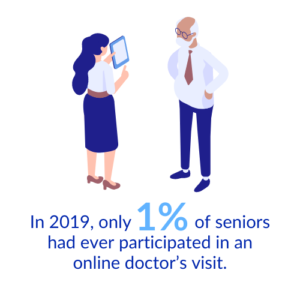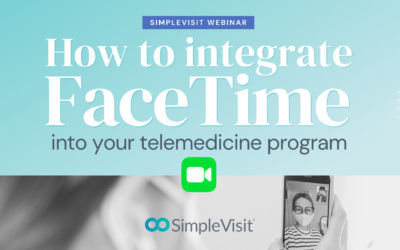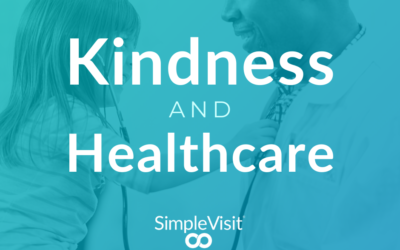How to Talk to Seniors (About Telemedicine)
Allie Clark | 10 min read | November 13, 2020
In the midst of an unprecedented healthcare crisis, it’s important to be mindful of some of the most vulnerable members in our communities: our seniors. This particular season has been uniquely challenging for older patients, in part, because of the dependence on telemedicine.

This particular demographic has historically been the most reluctant to adopt new technology, especially remote care over video. In 2019, only one percent of seniors had ever participated in an online doctor’s visit.
For patients above sixty-five years old, this is based in a fear of the unknown, a belief that since the solution is new and tech-based they won’t be able to operate or understand it, and a hopelessness in feeling like they are alone trying to deal with all these new and uncomfortable experiences. These worries are only amplified by the inherent loneliness and lack of resources due to necessary self-isolation and social distancing. When offered help or assistance from those in a younger age-bracket, cross-generational communication difficulties can complicate the issue and cause more confusion than resolution.
At SimpleVisit, we offer support and careful attention for older patients and providers apprehensive about telemedicine technology. Our live telemedicine receptionist is a unique feature of our managed telemedicine service. These receptionists thoroughly and effectively walk patients through a video platform, no matter the patient’s age or level of technical expertise. Throughout the pandemic our team has developed strategies that ease the tension and facilitate a smooth process when helping a geriatric patient use FaceTime for the first time, find their Skype username, download and operate Google Hangouts on their brand-new tablet, or turn on the audio and video once they’ve entered a Google Meet link. All these scenarios require a certain level of intentionality in the communication choices we make in order to ensure that both patient and provider walk away with a user-friendly experience, one of the commitments of our brand.
It’s becoming more important than ever to protect our senior patients’ access to care, whether you are in a Geriatric speciality care practice or simply have a higher concentration of patients over 65. In fact, that is the case for most practices right now. The American population is getting older, in a large part due to the children of the Baby Boomer generation. From the Urban Institute in a study done in the year 2000:
“The number of Americans ages 65 and older will more than double over the next 40 years, reaching 80 million in 2040. The number of adults ages 85 and older, the group most often needing help with basic personal care, will nearly quadruple between 2000 and 2040.”
In February, just prior to the onslaught of COVID-19, the National Academies of Sciences, Engineering, and Medicine (NASEM) published a study on Social Isolation and Loneliness in Older Adults. This was quoted by the CDC, who notes that “more than one-third of adults aged 45 and older feel lonely, and nearly one-fourth of adults aged 65 and older are considered to be socially isolated.” Their article also outlines the major health problems that care arise out of increased loneliness and isolation in older adults:
- “Social isolation significantly increased a person’s risk of premature death from all causes, a risk that may rival those of smoking, obesity, and physical inactivity.
- Social isolation was associated with about a 50% percent increased risk of dementia.
- Poor social relationships (characterized by social isolation or loneliness) was associated with a 29% increased risk of heart disease and a 32% increased risk of stroke.
- Loneliness was associated with higher rates of depression, anxiety, and suicide.
- Loneliness among heart failure patients was associated with a nearly 4 times increased risk of death, 68% increased risk of hospitalization, and 57% increased risk of emergency department visits.”
We here at SimpleVisit want to help you talk to your senior patients about telemedicine. To help you do that, we sat down with some of our team members to get their advice and guidance, gleaned from real-life experiences working with this demographic in telemedicine patient support.
“Be patient and explain every step (even though it may seem obvious.)” – Grace K.
“Talk slowly and give one step at a time.” – Savannah N.
This is technology that some of your patients have never used before. Keep that fact in the front of your mind and try to approach guiding them in this experience with as much empathy for their lack of exposure as possible. Also, as we age, hearing loss and delayed cognitive processing can be a normal part of the process. Be sensitive to that as you explain technology or instructions.
“Don’t talk to them as if someone else is taking care of them – they are independent & intelligent.” – Savannah N.
“Reassure the patient that they are capable of doing this, no matter how technologically challenged they feel they are.” – Lauren M.
These days, more seniors are aging in place than ever before – and in a time of social distancing many are not relying on outside help either. That being said, they made it to this point in life by their own ability and skills – whatever they lack in experience with the technology, they more than make up for in capability and potential for understanding. When you approach them with that belief held firmly, you will inspire the confidence that is the number one key to success in learning a new skill; if you think you can, you can.
“Carefully word any instructions to ensure you are “bridging” the next step (unknown) with something they currently see (known).” – Rob W.
“Use simple terms – steer away from industry lingo or words that are inherently technical.” – Grace K.
Reducing confusion should be a top priority, as there is likely to be an assumption of complexity before you start helping them. The simplest way to do this is to be intentional in the words you choose. Use terms that are common in conversations that are not industry related – for example, video visit, virtual care, remote healthcare, video call, etc. Helping them to associate each new step or process with one they have already mastered is another way to reduce confusion and uncertainty. The more you can normalize the process the more comfortable they will become.
“Give them an idea of what the result is that they are working towards to help manage their expectations for the end of the process.” – Gabriel T.
“Ask them to repeat back what they see on their screen.” – Samantha B.
Letting them know what you are trying to do will help to put context to the individual instructions you are giving them. It also lets them know when they’ve arrived! The feeling of accomplishment when you reach an expected goal is always better than not realizing you’re done – it’s something to work towards. If they get lost in the middle and you’re not sure how to get them back on track, asking them to describe what they’re seeing and where they are in the process can also be extremely helpful. This is a great way to ensure that they are on the page that you want them to be on. Sometimes if you just ask them “Do you see this option?” versus “Tell me what you see on your screen,” it only serves to increase their confusion. Since we are trained to know the applications front and back, once we know what they’re seeing, we should be able to guide them from there!
“Be sincere and genuine.” – Lauren M.
“Try to create a personal connection – let them know they are not alone.” – Allie C.
Unfortunately, in our society, seniors are especially likely to be both scammed and placated. As a result, they are particularly sensitive to a lack of sincerity or forced patience. Keeping in mind what they must be experiencing, amidst a time of disease, isolation, and new technology, will help to lend your encounters a quality of honesty that will put them at ease. All of us have muttered “I hate technology,” under our breath at one point or another as well. Even the most tech-savvy user has dealt with the many frustrations that come along with the benefits. Share that with them. Let them know by saying the words that you feel their pain, even in a small way, and that we are all figuring this out together. If they seem to be feeling particularly alone or overwhelmed, sharing with them an anecdote of a time you struggled with new technology (because we all have at least one) could be exactly what they need.
Improving how you communicate with your geriatric patients is the best way to help them as they adjust to the radical change in healthcare delivery that we are all experiencing. However, what type of service or technology can also play an important part in your senior patients’ success in using telemedicine. Our best advice: Choose a user-friendly solution with plenty of technical support, troubleshooting, and patient resources. While there are other good choices for this use case, SimpleVisit has the only managed telemedicine service on the market with live telemedicine receptionists and call support specialists – these features and more make it an excellent vendor pick when you’re designing your telemedicine program with seniors in mind. Take a look at our Patient Support Resource Page, our most recent article on how to build a telemedicine program, or visit our Resource Library to browse a collection of resources ranging from billing & coding, reimbursement policy and best practice guidelines.
FiIl out a Buyers Guide TODAY to see how SimpleVisit can help you!
How to Integrate FaceTime for Telemedicine
Rob Warlick | 3 min read | April 23, 2021During the public health emergency, direct FaceTime calls are permitted for healthcare. Outside of that waiver, SimpleVisit is the only HIPAA-compliant way to bridge in FaceTime and other video calling apps. With over 620...
Using FaceTime for Telemedicine in 2021
Rob Warlick | 4 min read | January 26, 2021 In response to the global pandemic and the public health emergency, many medical groups have purchased or crafted a solution to treat over video. Due to the lax in federal regulations, many are turning to commonly available...
Kindness and Healthcare
Allie Clark | 10 min read | December 2, 2020It is time for some kindness. The holiday season can be a rough time for many among us. A report from the National Alliance on Mental Illness shows that this time of the year negatively affects a majority of people suffering...



